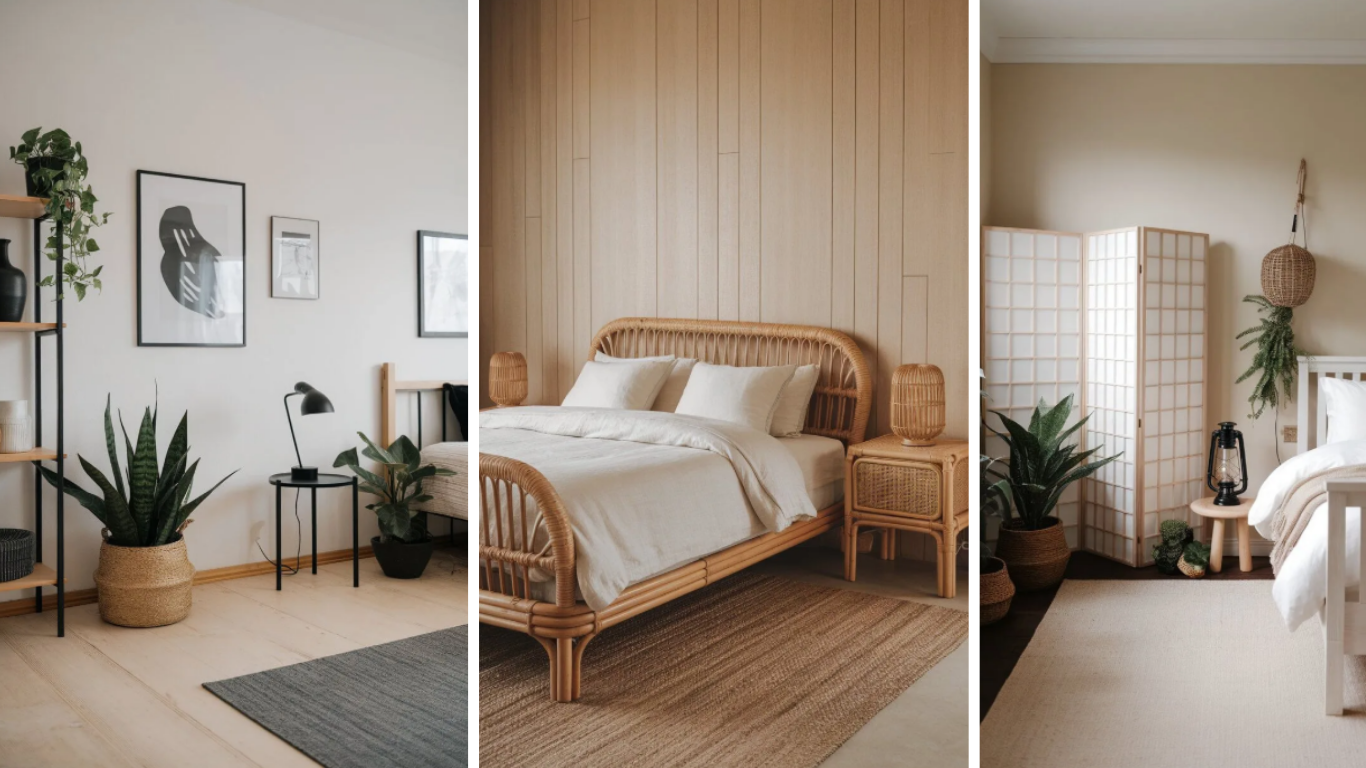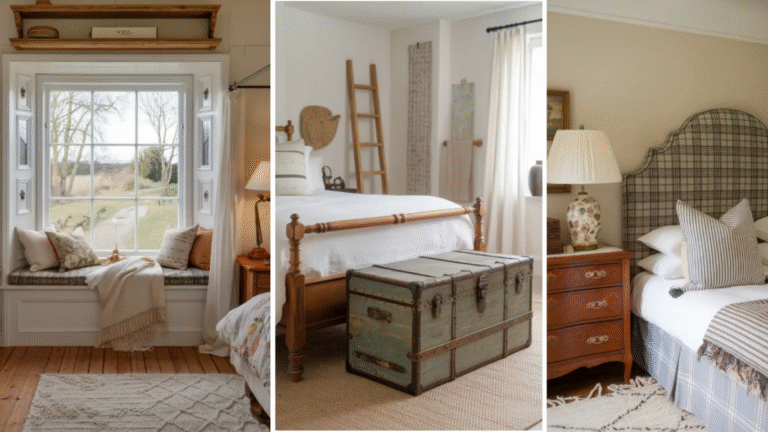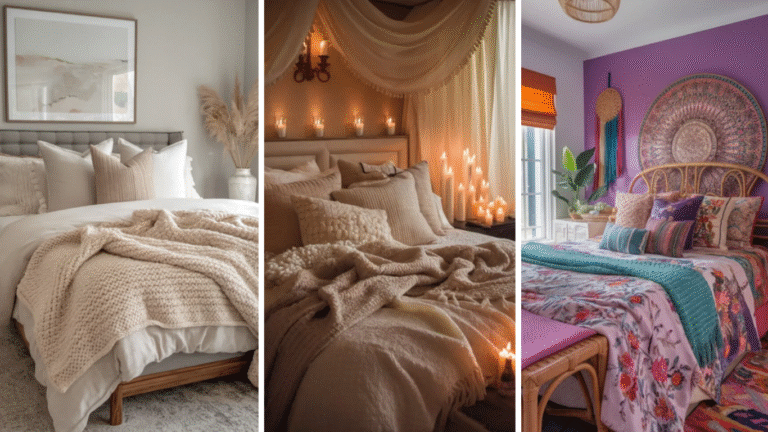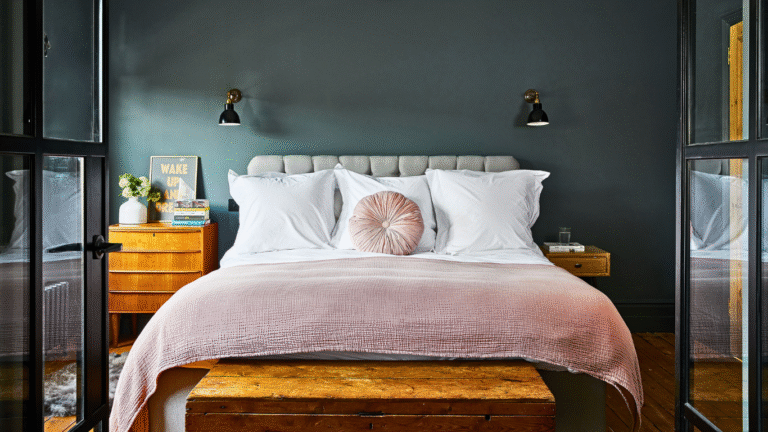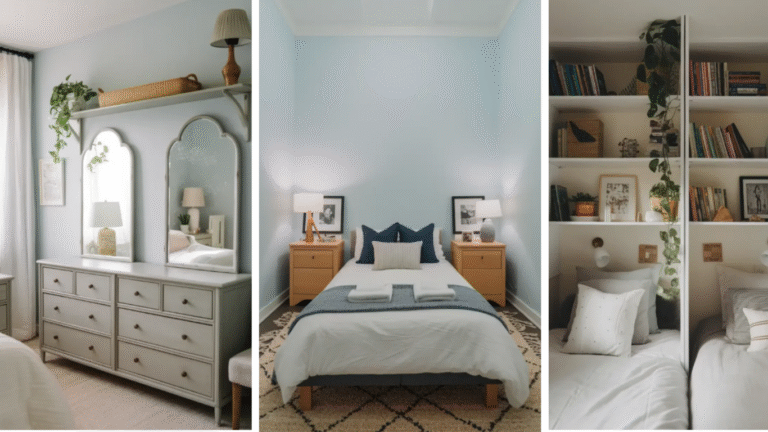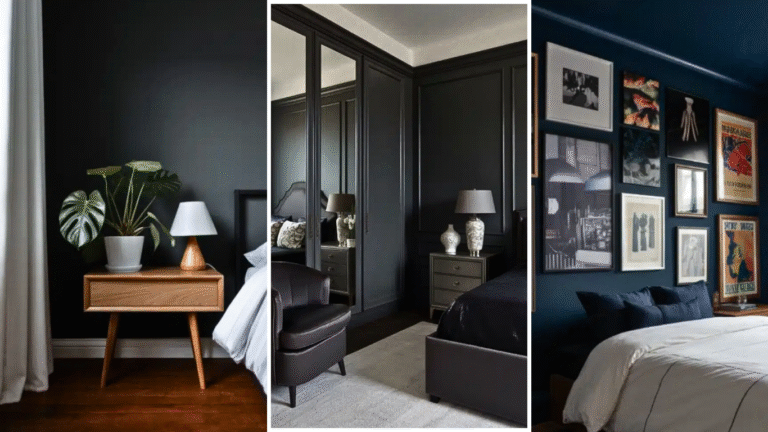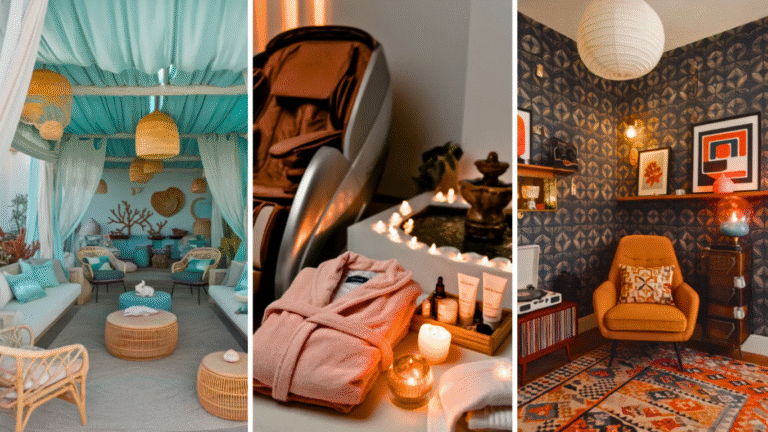15 Japandi Bedroom Design: Minimalist & Cozy Decor Ideas
Before diving into the actual ideas, it’s important to understand the guiding principles of Japandi interiors. This style is built around three main components that shape the look and feel of a Japandi bedroom.
First is the use of low-profile furniture, which keeps beds and nightstands close to the floor, creating a calming and balanced environment. Second is the emphasis on natural materials like wood, bamboo, linen, and wool—these choices not only bring visual warmth but also support sustainability.
Third is the Wabi-Sabi concept, a Japanese philosophy that finds charm in imperfections. Adding handmade, slightly asymmetrical pieces gives the space authenticity and a lived-in comfort that feels real, not overly styled.
1. Low Bed Frames

A key visual element of Japandi bedrooms is the use of low beds that hug the floor, offering a sense of calm and openness. These beds help create a minimal, breathable feel in the room, especially in smaller spaces where too much height can make things feel crowded.
Pair the frame with natural cotton or linen sheets in light shades for a clean look, and layer on textured blankets or throws to maintain the cozy aspect. The mattress itself should be plush yet simple, complementing the low silhouette. Nearby, a small wooden nightstand with minimal design can serve as both a functional and aesthetic addition, especially when topped with a small plant or a soft, ambient lamp.
2. Neutral Color Palette

To achieve a Japandi bedroom, stick to a quiet and neutral color scheme that fosters calm and relaxation. Whites, greys, and soft beiges should form the base of your design, creating a sense of order and stillness. These tones help reduce visual noise and encourage mindfulness in the space.
For a bit of subtle character, introduce muted earthy shades like terracotta, olive green, or taupe through small decorative items like throw pillows or ceramics. Layering light neutrals with slightly deeper tones—like charcoal or dark brown—adds visual depth while maintaining the overall clean and balanced look of the room.
3. Wood Slat Accent Walls

Wood slats can completely transform a plain bedroom wall into a warm and eye-catching feature without straying from the Japandi theme. Whether placed vertically or horizontally, these slatted panels give the space texture and rhythm while staying subtle.
Lighter woods like ash or birch bring out the Scandinavian side of Japandi, while darker woods like walnut or teak echo Japanese tradition. They’re especially effective as a backdrop for a bed or as a feature wall on one side of the room. In some cases, slats can also be designed to conceal hidden lighting or even act as a headboard, combining functionality and elegance seamlessly.
4. Layer Textures

Texture plays a huge role in Japandi interiors, allowing a space to feel rich and inviting without needing lots of visual decoration. Instead of adding more items, layering textures helps create depth. Think linen bedding over cotton sheets, with a wool or jute rug underfoot.
You can add cushions with woven, tufted, or knotted details to enhance the tactile experience. A soft throw with fringes can round out the look, giving the space a lived-in feel. The key is not to overwhelm the room—Japandi favors a few well-chosen textures over excessive variety.
5. Natural Light

One of the easiest ways to elevate a Japandi bedroom is by maximizing natural light. This means choosing window treatments like sheer linen or cotton curtains that let light pass through gently, keeping the room bright while maintaining privacy.
These fabrics help soften direct sunlight and preserve the room’s relaxed mood. For spaces that don’t get a lot of natural light, strategically placing mirrors can help bounce the available light around, making the room appear more open and airy.
If your room has access to large windows or even a skylight, treat these as design focal points that strengthen your connection with nature.
6. Angular Wooden Furniture

Japandi bedrooms benefit from furniture with sharp, clean lines that reflect simplicity and purpose. Whether it’s a low dresser, a narrow wooden bench, or a geometric chair, the key is to keep shapes crisp and designs intentional.
Go with pale woods like oak or pine if you want to lean into Scandinavian brightness, or darker tones like walnut and teak for a more grounded Japanese vibe. Many of these pieces also offer smart storage, such as drawers built into bed frames or seating that opens up to store blankets.
This helps maintain the uncluttered atmosphere essential to Japandi.
7. Nature-Inspired Art

Artwork in a Japandi space should feel calming, organic, and connected to nature. Think of simple illustrations of leaves, minimal landscapes, or abstract pieces in warm earth tones like soft green or clay.
Framed art with thin borders, hanging scrolls with Japanese calligraphy, or muted Scandinavian prints all fit beautifully into the theme. You don’t need bold statements—just pieces that bring in a quiet beauty.
You can also consider decorative ceramics or small sculptures that double as both art and texture, blending seamlessly into the overall decor.
8. Tall Greenery

Tall indoor plants bring life, height, and natural movement to a Japandi bedroom. Choose plants like fiddle leaf figs, snake plants, or bamboo stalks, which complement the style with their upright shapes and clean leaves.
These plants work especially well in contrast to low-profile beds and furniture, helping to draw the eye upward and balance the room. Use simple, earthy pots in clay, ceramic, or concrete to ground the greenery in the overall neutral palette.
Beyond looks, plants offer real benefits—purifying the air and adding a peaceful, organic presence to your space.
9. Under-Bed Rugs

A carefully placed rug beneath the bed helps bring everything in your room together. It softens the floor, warms the space, and makes the bed feel like a true centerpiece. Look for large rugs in neutral colors like cream, beige, or soft grey that extend past the sides and foot of the bed for a cohesive look.
Choose subtle patterns or lightly woven textures to add interest without stealing focus. The right rug provides a tactile contrast to wood or tile flooring while supporting the layered, minimal comfort of Japandi interiors.
10. Globe Lighting

Soft, glowing lighting is essential in setting the mood for a Japandi bedroom. Globe lights—whether they’re ceiling pendants, bedside lamps, or floor lights—offer a warm, gentle brightness that enhances relaxation. Materials like frosted glass or matte metal keep the fixtures looking refined and simple.
For the best effect, layer your lighting sources at different levels across the room. This means combining overhead lights with ambient lamps and accent lighting to create depth, comfort, and balance in both function and atmosphere.
11. Rustic Accents

Handmade decor adds personality and character to a Japandi room. Pieces like wooden trays, handmade ceramics, and woven wall hangings add depth and texture while staying true to the overall aesthetic.
These rustic accents highlight craftsmanship and often feature minor imperfections that echo the Wabi-Sabi mindset. A slightly uneven vase or a rough-edged bowl isn’t a flaw—it’s a statement. These details keep the space from feeling too polished and instead invite warmth and authenticity.
12. Clutter-Free Nightstands

Nightstands should be both useful and visually clean. Choose ones with drawers or shelves to hide everyday items like books, chargers, or glasses, keeping your surfaces open and neat. Limiting visible clutter helps maintain a sense of calm and clarity in the room.
If you’d like to decorate your nightstand, keep it minimal—one small item like a ceramic candleholder or a single-stem vase is enough. Japandi values thoughtful simplicity over decoration for its own sake.
13. Black Accents

Even in a space filled with soft, light colors, a few dark touches can make everything feel more grounded. Add just a hint of black—maybe a sleek lamp, a picture frame, or a minimal black vase—to bring contrast and structure.
These elements give visual weight and help define edges in an otherwise airy space. For a more natural look, choose black finishes in matte textures or raw materials like stone or iron rather than glossy or plastic surfaces.
14. Functional Decor

Every decorative item in a Japandi room should have a reason to be there. This means prioritizing objects that look good and serve a purpose. For instance, a room divider might also be a beautiful art piece, or a storage basket can double as floor decor.
Even something like a tea set or a sculptural lamp should have a role beyond appearance. This thoughtful approach helps avoid clutter while reinforcing the Japandi belief in intentional, balanced design.
15. Woven Accessories

Woven details made from natural materials—like rattan baskets, bamboo pendant lights, or jute rugs—are a perfect match for Japandi spaces.
They add warmth, texture, and a handcrafted feel while supporting the clean, organic look. These accessories are also practical: use baskets to store linens, place woven trays on tables, or let a natural fiber rug anchor the room. Each item contributes to both the style and the function of the space, tying everything together in a simple, beautiful way.
Conclusion: ( Japandi Bedroom Design )
Creating a Japandi bedroom goes beyond picking stylish furniture—it’s about setting up a peaceful environment where every detail feels intentional. By focusing on low furniture, earthy textures, natural light, and a clutter-free layout, you can turn your bedroom into a place that supports rest and well-being.
Whether you’re adding a soft throw, a handcrafted ceramic piece, or switching to a calming color palette, even small changes can bring a noticeable sense of calm. These ideas aren’t just trendy—they’re rooted in time-tested design principles that promote balance and simplicity. Start with what you can, and build your way to a space that feels truly serene and personal.
To know about Twin size bedroom ideas, check it: https://homesdecorzone.com/twin-size-bedroom-ideas/

